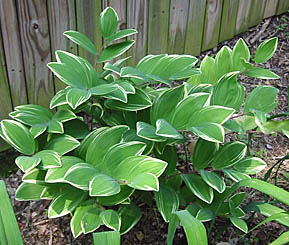Beauty Beyond Blooms – Really!
By George Graine, Fairfax Master Gardener
Perhaps our best hope for gardening as an art is that gardening is an activity whose never-achieved aim is progress towards a never-completed work of art.
–Geoffrey Charlesworth in The Opinionated Gardener (1988)

Hostas, ferns, hydrangea, aucuba, holly, and euonymus combined in a foliage garden
Perhaps it is time to give foliage a break, especially when considering the longevity of foliage compared to most flower blossoms. If you have successfully planned a garden to produce a succession of blooms, that is all for the good. But how many of us have been able to do that, especially when coping with fickle Mother Nature? Experience tells us you cannot realize an excellent succession of flowers without a lot of effort and, often, without some fair financial resources.

Variegated Canna “Pretoria”
With careful recognition of flower production and a lot of work, you can surely have a colorful display. But is choosing a riot of color or a single-palette of color all there is? Of course not! When the flower is finished, you should have interesting-shaped leaves of many sizes, textures and colors. Aside from these attributes, many foliage plants have vertical and horizontal stripes, sprinkles, mottled patterns and unexpected variegation. No doubt, with careful plant selection and an eye toward foliage, you will add zest to your garden and landscape.
Foliage is a critical design element for the garden and ought to be factored in regardless of sun, shade and other environmental variables. Perhaps it is time to put to rest the idea that foliage plants should be relegated to only a natural shade or woodland garden. That is pure nonsense. Challenge yourself by combining flowers and foliage to create a mood that reflects your tastes, not the preference of some famous landscape designer. Having an awareness of what plants will look like and knowing flower color and foliage will ensure that you achieve a balance that suits your personality and sense of design. Of course, you need to account for environmental conditions, soil quality and the like. Sometimes it can even be an interesting challenge to push the boundaries beyond accepted cultural “requirements,” such as a plant-hardiness zone.

Variegated foliage of Solomon’s Seal
Go for it! This is your garden. Be creative. Be bold. Be strategic. By mixing plants with unusual foliage, you are bound to create visual interest because foliage is much more than just a bunch of green leaves.
George Graine is a garden writer whose work often appears under the moniker, The Grainethumb. He writes a garden blog by the same name.
Grainethumb’s Favorite Foliage Plants
Trees
Dogwood: Cherokee Sunset (partial sun)
Japanese maple: weeping red or green (partial sun)
Japanese maple: Autumn Moon (partial sun)
Beech: Tri-color (partial sun)
Ginko (sun)
Shrubs
Smoke Bush: Royal Purple or Golden Spirit (sun)
Harry Lauder’s Walkingstick (sun)
Nandina: Flirt, Plum Passion (sun)
Boxwood: Elegantissima, Golden Dream, Wedding Ring (partial shade)
Hinoki Cypress: (sun)
Azalea: Bollywood (partial shade)
Weigela: My Monet (dwarf), Midnight Wine (dwarf), Fine Wine, French Lace (sun)
Yucca: Color Guard, Gold Sword (sun)
Perennials
Brunnera (partial shade)
Hosta (partial shade)
Heuchera/Heucherella/Tiarella (partial shade)
Lamium (partial shade)
Ajuga: Burgandy Glow (partial shade)
Ivy: Gold Heart, Sulphur Heart, Glacier, Fluffy Ruffles (partial shade)
Wild Ginger (partial shade)
Variegated Solomon’s Seal (partial shade)
Variegated Pachysandra (partial shade)
Variegated Vinca minor: Illumination, Sterling Silver (partial shade)
Variegated Iris (sun)
Ornamental Grass: dwarf varieties (sun)
Painter’s Palette (sun)
Houttuynia cordata ‘Chameleon’, best to constrain in a container (sun)
Tropicals (must be overwintered inside)
Caladium: (shade)
Canna: Pretoria, Tropicanna, Stuggart (sun)
Colocasia (Elephant Ear): Mojito, Illustris, Black Coral (sun)